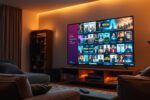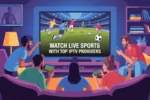Programmatic Advertising Explained: How Tech is Transforming Brand Reach
Let’s cut through the jargon:
Programmatic advertising isn’t the future — it’s already here, and it’s rewriting the playbook.
If you’re still buying ad space manually, negotiating rates over emails, and guessing who will see your ads… you’re officially a dinosaur.
Programmatic is now the backbone of smart, scalable brand growth in 2025.
Here’s everything you actually need to know — simple, human, and no buzzword bingo.
Disclaimer: We don’t sell IPTV services. We don’t sell apps. We don’t take commissions.
What we actually do? We test, research, compare, and simplify. We dive into forums, scroll through tech blogs, install all kinds of apps (even the weird ones), and package everything into useful shortcuts you can trust.
We’re just a bunch of nerds obsessed with tech, doing our best to save you time and headaches. Everything we write comes from real testing and experience — no fluff, no hype, no bias.
Use it, test it, question it. We’re not here to sell — we’re here to help.
What is Programmatic Advertising (In Plain English)?
Programmatic advertising = automated buying and selling of online ad space.
Instead of calling a rep or emailing for placements, algorithms now:
-
Buy ads
-
Target users
-
Set bids
-
Optimize campaigns
All in real-time, automatically.
✅ Think of it like the stock market — but for ads.
You tell the machine what you want (who to target, how much to spend, where to appear), and it does the heavy lifting faster than any human ever could.
📈 According to Statista’s 2025 Programmatic Report, over 91% of all U.S. digital ad spend in 2025 is now programmatic.
How Programmatic Advertising Actually Works (Simplified)
Here’s the high-level process:
-
You define your audience: demographics, interests, online behaviors, etc.
-
You set your campaign goals: brand awareness, leads, sales, app downloads.
-
Platforms run real-time auctions: every time a user loads a page or app, an auction happens behind the scenes in milliseconds.
-
Your ads are automatically served: if you win the auction, your ad shows up instantly.
-
AI optimizes performance: adjusting bids, placements, creatives based on live results.
✅ Platforms doing this today include:
-
Google Display & Video 360
-
The Trade Desk
-
Amazon DSP
-
Xandr
-
AdRoll
Why Programmatic is Transforming Brand Reach
Before programmatic:
-
Brands relied on direct publisher deals.
-
Targeting was broad and inefficient.
-
Scaling was slow and manual.
With programmatic:
-
Ads follow your customers across devices and platforms.
-
Budgets optimize in real-time.
-
You reach the right person, at the right time, with the right message.
🎯 Sites like TopFirestick.com show how consistent, smart placements build brand familiarity — a mindset powered by programmatic at scale.
✅ Smarter reach. Lower cost per impression. More personalization.
The Key Types of Programmatic Deals
Not all programmatic is created equal.
Here are the big ones you should know:
| Deal Type | What It Means |
|---|---|
| Open Auction | Anyone can bid — widest reach but lowest control |
| Private Marketplace (PMP) | Invitation-only auctions for premium inventory |
| Programmatic Direct | Guaranteed impressions at pre-agreed rates, still automated |
| Preferred Deals | Brands negotiate first dibs on inventory before open auctions |
✅ If you want premium placements (like CNN, ESPN, Forbes), PMPs and Preferred Deals are where smart brands play.
Real Benefits of Programmatic (Beyond the Buzz)
Why the smartest brands in 2025 are fully programmatic:
-
Laser-sharp targeting: Geo, device, interests, behaviors, even time of day
-
Speed: Campaigns can launch and scale in hours, not weeks
-
Cost efficiency: Real-time bidding ensures you never overpay
-
Better reporting: Full-funnel visibility from impression to conversion
-
Personalization: Dynamic creatives adjust messaging based on audience segments
✅ It’s not just about reach — it’s about relevant reach.
Challenges to Watch Out For (No System is Perfect)
-
Ad fraud: Invalid traffic is still a risk — use trusted verification partners.
-
Brand safety: Ads can show up on low-quality sites if you’re not careful. Always set blocklists.
-
Complexity: Managing programmatic in-house requires serious skill — many brands work with DSP specialists or agencies.
✅ Pro Tip:
If you’re new, start small through managed service providers who handle programmatic buying for you until you scale.
📉 Studies from MarketingProfs show that brands who audit placements monthly see 25% better ad effectiveness and avoid wasted spend.
Real Talk: Programmatic Winners vs Programmatic Strugglers
| Strugglers | Winners |
|---|---|
| Rely on default settings | Customize audience and placement strategy |
| Ignore brand safety lists | Proactively block low-quality sites |
| Overpay in open auctions | Negotiate private deals or preferred rates |
| Let AI run everything blindly | Combine AI + human creative oversight |
Closing Thoughts
Programmatic advertising isn’t just “tech hype” anymore — it’s the foundation of serious, scalable brand reach.
If you’re still stuck in old-school media buying:
-
You’re too slow.
-
You’re overspending.
-
You’re missing your best customers.
✅ Lean into automation.
✅ Master audience strategies.
✅ Marry human creative with machine intelligence.
Because in 2025, brands that automate smarter reach — win bigger.





